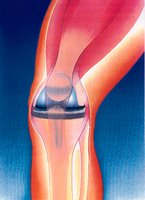Artificial Knees: After Two Years, the Doctor Deems Knee Replacements as "Perfect"
That's what my orthopedic surgeon at Mass. General in Boston said about my two-year-old knee replacements after studying the x-rays. He and the x-rays are shown below. I came into his office saying that I was concerned because I had been really pushing it with the knee replacements, playing singles tennis and doing a lot of heavy lifting building stone walls.

When he said, the knees were perfect, I was surprised. "You don't see any wear and tear?" I asked.
"Not at all," he said. "The knees look just the way they should."
"Isn't this excellent outcome kind of unusual, considering all the stress I'm putting on these knees?"
"No," he said flatly. "It's typical, actually."
And here I was thinking that I was some kind of a hero. All I am is a run-of-the-mill success story. For months, I have been telling people about how wonderfully successful my knee replacements are, strongly implying that I deserve the credit."
"I really worked on the rehab," I told people.
I was somebody. Now I'm back to being a nobody again. Oh, well ....
It's a measure of how far medicine has advanced. Ten years ago, a guy like me running around playing tennis and walking miles with artificial knees would have been a celebrity. I would have been been on Oprah. While a clip ran of me playing tennis, I would have been talking about what it's like being a medical miracle.
Woulda, coulda, shoulda. Instead, my surgeon tells me I'm "typical." Oprah does not call. Even the local rag can't find any news in the fact that I'm playing tennis
 on titanium knees. I'm the only one who thinks I'm a hero.
on titanium knees. I'm the only one who thinks I'm a hero.Wounded ego aside, everybody else is probably right of course. My surgeon does hundreds of total knee replacements a year. He and many other joint-replacement doctors have assembly lines going, no doubt with lots of good outcomes like mine.
Ed, 64 and a member of our tennis group just had arthoscopic knee surgury. He was told that he would probably need both knees replaced within 10 years.
"I'd have them done sooner rather than later," I told him when I called to see how he was doing.
"Now that I see what you're doing with those knees," Ed said, "I would consider having them done sooner. I know that I can still play tennis."
Thank you, Ed, for giving my faded star a farewell whirl.
Tall, a strong and highly competitive player, Ed is a former star basketball player at Assumption College and today is a successful tennis coach at St. John's in Shrewsbury, Mass. He's going to call me when he is ready to hit.
Another member of the tennis group, Connie, pictured below on crutches, just had his left knee replaced two weeks ago. A former tennis star at Yale and one of the best tennis players to come out of Worcester, Connie, 72, is home recovering his strength. He is walking with the help of the crutches and trying to decide where to go for rehab.
I stopped by to see him and we had a nice long chat. He was upbeat and in good spirits but said he was in a lot of pain. And for Connie to say so, told me that his pain must be excruciating.
His left leg, with the replaced knee, is straight compared to the bowlegged right knee. Before my replacements I was as bowlegged as a saddle-worn cowboy. With my new knees, I grew about two inches and Connie says he is taller already.
He is taking a painkiller, Vicodin, but it doesn't seem to help much. He says the pain is 24/7 and he is wondering if he should stop taking the painkiller since it doesn't seem to be doing anything for him.
My free advice was to stop. "What's the point if it's not helping?"

I told him that, generally speaking, I think we are all better off relying on our bodies rather than drugs. He agreed but would rather hear it from someone more qualified than I. I did tell him that I got off the painkiller, Percocet, as fast as I could, within a few days. The pain began to decrease a few days later and then quickly went away.
We talked about rehab. Continuing to dispense free unqualified advice, I told Connie I thought that rehab was key to a good outcome."Most of the people I saw in rehab didn't work," I said. "They expected the therapist to do the work for them. It works just the opposite."
Most of the people I met in rehab had very low expectations. The typical goal is to get walking again. I was the only one in my groups with a goal of getting back playing a physically demanding sport like tennis. "Work like a dog, Connie," I said.
He wasn't even thinking tennis. He just wanted to get back to playing golf. But, knowing what a terrific tennis player he is, I pushed for tennis. By the time I left, I had the feeling that tennis was back on the table for Connie. In fact, one of these days I think I'll be seeing Connie on the other side of the net.
I hope so.
With all due respect to my surgeon, I have not met anyone whose outcome from total knee replacement has been as outstanding as mine. Maybe he hasn't, either. He looked at the x-rays and examined the knees on the table. "Excellent range of motion," he said.
"You don't know the half of it," I said to myself. He didn't see me run around on the tennis court for two hours, pain-free and chasing down balls the way I used to twenty years ago. I'd like to see him watch me do that and then tell me that I am "typical."
You know what? I'm annoyed. Typical, my ass.
Now that I am into a rant, I have met quite a few total-knee-replacement people whose outcome is so-so and a few whose outcomes were terrible. I have read of too many bad outcomes for excellent outcomes like mine to be reasonably described as typical.
I say this with great respect for my surgeon whose excellent outcomes are indeed legendary in the Worcester area. I see them running around on the tennis court. There's not a bad outcome among them. For my surgeon, maybe excellent outcomes are indeed "typical."
I'm still annoyed because I do not think that this is generally true in the knee-replacement universe. Some doctors get better outcomes than others, though this information is almost impossible to get in writing. And there are just too many bad outcomes for mine to be typical.
Let me tell you about my friend, Jane Brody, pictured below. Well, she's not really my friend. She is the personal health columnist with The New York Times. She has held the job for thirty years. I have read so many of her articles that I feel that I know her, especially since she sometimes lets us in on her own personal health issues -- such as the replacement of her
 seriously arthritic knees with titanium ones.
seriously arthritic knees with titanium ones.On December 15, 2004, at age 63, she had double knee replacement surgery "at a leading orthopedic hospital" which she does not name. But you can be sure, given her wealth of medical information, that her surgeon and hospital are top-flight. (My surgeon declined to do both knees at once, saying that there is increased risk and that he "never does anything that increases risk.")
By February, Ms. Brody was writing about postoperative problems, primarily intense and prolonged pain. She wrote that many letters from other patients described similar experiences with terrible pain that was not adequately recognized and treated after they left the hospital. Far fewer letters described a much quicker -- in a matter of weeks -- and less debilitating recovery.
Several orthopedic surgeons wrote Ms. Brody to point out that her extreme pain and prolonged recovery were not typical and that she was unduly scaring people who could benefit from the surgery. She says that was not her intent and that she only wanted patients to know that terrible pain can follow knee-replacement surgery.
Initially, Ms. Brody regained reasonable mobility quickly. But about seven days after the surgery, her pain worsened. The analgesic drugs she had been prescribed no longer controlled the pain. She was in constant agony and could not sleep.
Her internist finally prescribed a cocktail of drugs, including the long-acting narcotic OxyContin, which gave her some relief. While stepping up her walking, swimming, and riding an exercise bike, she continued taking the cocktail through April -- four months after surgery. By May, she had weaned herself off the coctail to avoid withdrawal symptoms.
But she was not yet done with pain. By late summer, she suffered debilitating pain in the right calf and right buttocks. It was diagnosed as sciatica and treated successfully with a shot of steriods. Then her left leg began to hurt. It was diagnosed as iliotibial band syndrome (ITB). She cut back on her walking and did stretching exercises and the pain gradually decreased.
Since her knee replacement surgery, Ms. Brody has been outspoken about the need for doctors to become more sensitive to and better informed about the great pain that can follow the surgery. She says that too many physicians are "clueless" about how to treat this postoperative pain.
In a follow-up column, a year after her surgery, Ms. Brody wrote:
"A word of caution: As with any surgery, knee replacement is not always perfect even in the best hands. I have met several people with lingering problems, including one who experienced permanent nerve damage and another who must use a cane despite a year of physical therapy and reassurance that her new knee is 'perfect.'"
"Perfect" I'm okay with. But how can my surgeon call a hero like me "typical"?
Grrrrrrrr.
So long and keep moving.
Update Aug 3, 2015
UPDATE February 28, 2014
"None. I don't even think about them. Thank you, thank you."
"Great, we'll see you in five years," he said, shaking my hand. And then he was out the door. I was in his office about ten minutes. For Dr. Burke, it was just another big success. For me, it is not only a life-changer but a life-saver.
In an early 2014 blog, I start off with the above X-ray and then crow about how my "beautiful legs" just took me all over Nantucket. Check out the story here.

Jane is abandoned as a baby and raised in multiple horrific foster homes. After her latest abuse, a sexual advance from her latest foster parent, she screams "NO!" and runs out the door Twelve years old, on the street, alone, no family, nobody, no money, how can she possibly survive? She can't -- except that Jane is no ordinary foster kid. She doesn't understand "can't." Read excerpts.
Billy Stone was a foster child.
He ran away from abuse.
He went to juvenile prison.
He went up from there.
And he did it his way.
With the power of the written word.
Amazon E-Books by George Pollock
A Beautiful Story
A Long, Happy, Healthy Life
I, Cadaver
Killers
State Kid
Unlove Story
Labels: "knee replacement" "artificial knees" "titaneum knees" "jane brody"





